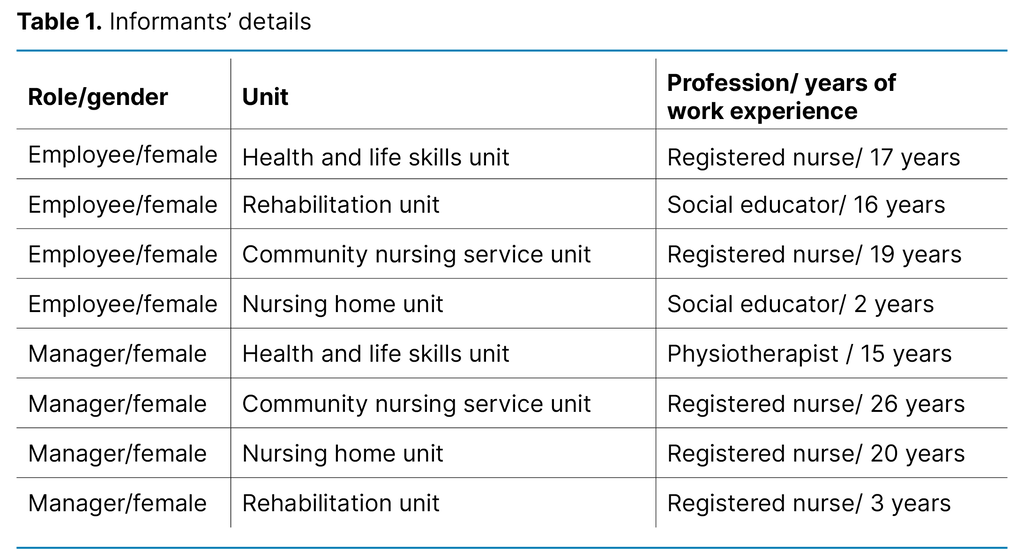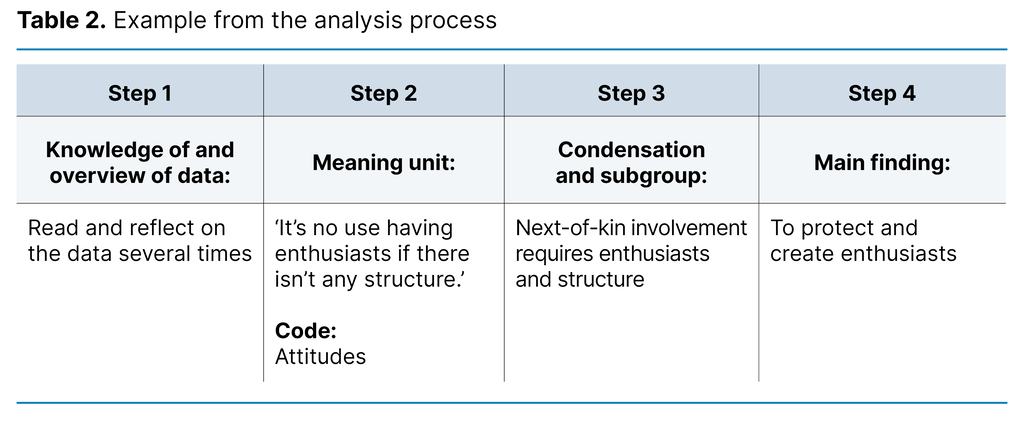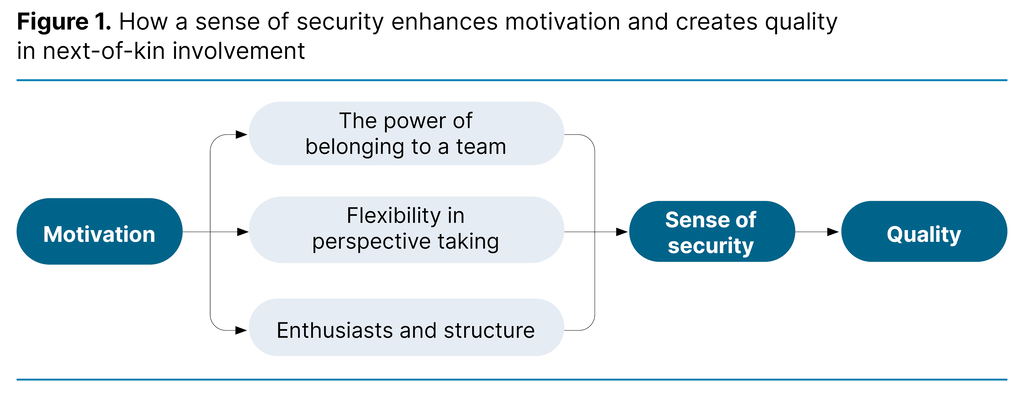The importance of motivation for the quality of next-of-kin involvement – a qualitative study of managers and employees in primary care services
Summary
Background: According to government policy guidelines and current legislation, it is important that efforts aimed at patients’ next of kin are an integral part of primary care services in Norway. However, research shows that motivation for next-of-kin involvement varies among employees and managers in primary care services, which in turn affects interactions and the quality of services.
Objective: The study aimed to examine how motivation affects the next-of-kin involvement efforts of managers and employees in primary care. This article focuses on the importance of motivation in the practice and quality of next-of-kin involvement in the primary care services.
Method: The study has a qualitative design with a hermeneutic approach, based on 16 semi-structured interviews with managers and employees in primary care services. We collected the data with the help of an interview guide. We analysed the data using systematic text condensation. The Consolidated Criteria for Reporting Qualitative Research (COREQ) checklist was used.
Results: The study shows that motivation can affect the quality of next-of-kin involvement. Reflection on next-of-kin involvement is a key prerequisite for achieving responsible next-of-kin involvement. The results elucidate three themes that are affected by motivation and that have a potential for promoting quality in next-of-kin involvement: 1) ‘The power of belonging to a team’; 2) ‘Flexibility in perspective taking’; and 3) ‘Enthusiasts and structure’.
Conclusion: The study builds knowledge on the connection between motivation and how next-of-kin involvement is practised. It shows that when healthcare personnel manage their own feelings, they are better able to deal with the reactions of next of kin. We identified useful processes for motivation. These may be of assistance when planning and carrying out next-of-kin involvement in primary care services. This involves the need to facilitate different arenas for reflection and guidance in which the reflection tool ‘FuelBox for professionals – about patients’ next of kin’ can be used. In addition, the study may have significance for how next of kin can tackle their role without becoming sick themselves.
Cite the article
Godeset I, Bergerød I. The importance of motivation for the quality of next-of-kin involvement – a qualitative study of managers and employees in primary care services. Sykepleien Forskning. 2024;19(94549):e-94549. DOI: 10.4220/Sykepleienf.2024.94549en
Introduction
From a public health perspective, new knowledge on the importance of healthcare personnel’s motivation for the quality of next-of-kin involvement will have a positive effect on all levels – from the micro to the macro level (1–4). Better next-of-kin involvement can result in more effective use of resources, financial benefits and increase the general interest in this area.
Active next-of-kin policy
National guidelines recognise patients’ next of kin as a resource, while also emphasising their need for involvement and support during the entire course of care in the health and care service (5, 6). The Report to the Storting (Meld. St. 29) (White Paper) Future Care (2012–2013) (7) points out that fruitful involvement with patients’ next of kin is a key priority area in future care policy.
The Official Norwegian Report (NOU 2018: 16) First things first (8) has a chapter on the needs of patients, service users and their next of kin. Together with national guidelines, current legislation makes clear that primary care services have a duty to inform, involve and support both children and adults who are patients’ next of kin (9, 10).
In summary, national guidelines indicate that healthcare personnel in primary care services have a duty to engage with next of kin in the daily follow-up of patients and service users.
Primary care services as a context
The local authority is responsible for facilitating professional health and social services for those who need them. Such services are to be provided regardless of a person’s age and diagnosis. The government is responsible for framework conditions and is to monitor these and carry out inspections. These are implemented via regulations and grants (11, 12). Next-of-kin involvement is included in the primary care services as a part of patients’ health care and as preventive health care for the next of kin, regardless of age or life phase (9, 13).
The national guidelines for next-of-kin involvement were developed by the Norwegian Directorate of Health in 2017 (5). The guidelines provide information on what next-of-kin involvement entails and how it should be practised. The objective is to ensure effective and professional next-of-kin involvement in the health service. However, recent research shows that although next-of-kin involvement is a priority area and an integral part of health care, only 34% of all employees in primary care services report being well-acquainted with the guidelines (14).
Growing interest in research
In line with the national guidelines and the authorities’ increased focus on the vital role of next of kin in relation to quality and safety in the health service, interest in research on the topic is growing. There are also a number of studies that deal specifically with motivation and quality in primary care services. One of these studies shows the importance of awareness and knowledge in enhancing the ability of nurses to overcome risks in situations that require self-regulation (14).
Another study shows that motivation is needed to introduce digital tools that improve the quality of the services (15). Some studies find that strategic next-of-kin involvement reduces stress and promotes engagement over time (16, 17). Norwegian studies link next-of-kin involvement to quality and safety (18, 19).
Other studies show that this form of involvement motivates health workers in clinical work to varying degrees (20, 21). Research does indeed show that involvement with next-of-kin and their motivation to help are of significance for the quality of health care (11). Knowledge, physical and mental conditions, management, finances and culture are all factors that affect healthcare personnel’s attitudes towards and practice of next-of-kin involvement (11, 18). One study highlights one of several FuelBoxes as a tool with the potential to promote communication (22).
FuelBox, which is included in this study, has been developed by the Pårørendesenteret (Next of Kin Centre) and quality assured by an external psychiatrist and a specialised psychologist. The aim of the box is to promote reflection on next-of-kin involvement by healthcare personnel. The reflective questions are divided into six categories that are based on the chapters in the national guidelines for next-of-kin involvement (5), while three categories address healthcare personnel on a personal level. Despite the fact that there has been a greater focus on next of kin and their support over the past two decades, studies are lacking on the importance of motivation for the quality of next-of-kin involvement practised by healthcare personnel.
Ryan and Deci’s self-determination theory is widely recognised and used in this area (23). It describes three innate psychological needs in human beings. The degree to which these needs are satisfied determines the feeling of contentment and well-being. The need for competence, autonomy and relatedness are therefore significant for the level of motivation felt in relation to behaviour and tasks (23).
When the psychological needs are satisfied, this lays the foundation for an autonomy-driven motivation. This is intrinsic and is characterised by interest in and enjoyment of the task (32). The facilitation of autonomy-driven motivation in healthcare personnel can have significance for efforts to improve the quality in primary care services’ next-of-kin involvement . When healthcare personnel have the requisite knowledge of the needs of next of kin and are given the opportunity to make autonomous decisions by having a greater scope of action, an interest in next-of-kin involvement can, to a greater extent, grow from within.
Objective of the study
The study aimed to examine how the motivation of managers and employees in primary care services affects next-of-kin involvement.
The following research question formed the basis of the study:
‘How can the motivation of managers and employees in primary care services affect the quality of next-of-kin involvement?’
Method
Sample and data collection
In the study, we focused on a local council that introduced a pedagogical tool to enhance the quality of next-of-kin involvement through reflection. The reflection tool ‘FuelBox for professionals – about next of kin’ consists of reflection cards for healthcare personnel. The tool was introduced during a seminar with a clear request to use it in the four units of the primary care services (24). The FuelBox concept has previously been applied in a Norwegian context (22, 25).
Our study has a qualitative research design with a hermeneutic approach (26, 27). The sample consisted of eight female informants from the four units in the primary care services: health and life skills, rehabilitation, the community nursing service and the nursing home. We conducted 16 semi-structured interviews. One manager and one employee from each unit were interviewed twice. The informants have bachelor-level qualifications in health studies; they are physiotherapists, registered nurses and social educators. They had from 2 to 26 years of work experience (Table 1).

The informants were recruited via an information sheet distributed by the municipal project leader. The study was based on the principle of voluntary participation (28). We included both managers and employees from the different units to ensure the collection of data from various levels in primary care services.
The study is based on empirical data collected from semi-structured interviews using the associated interview guide, which was adapted for two interviews per informant (Appendix 1 – in Norwegian).
The interviews were recorded using the Nettskjema application (University of Oslo) to ensure secure storage in line with the approval from the Norwegian Centre for Research Data (NSD). The interviews were carried out in the period from June to December 2021. They were conducted in a separate room in the local council’s offices. Two of the interviews were conducted digitally due to the ongoing pandemic. The first author carried out both the interviews and the transcription.
Data analysis
We carried out systematic text condensation of the transcribed data (26, 27). By reading all of the interview texts several times, we gained an overall impression of the data. Then we identified and coded meaning units as follows: ‘Actions’, ‘Attitudes’ and ‘Feelings’. Subsequently, the content of the meaning units was condensed and placed in subgroups (26).
The meaning of the data was summarised in themes and interpreted according to the study’s theoretical perspective in general and self-determination theory in particular. For the purpose of validity, we performed the analysis both individually and together in analysis seminars, which promoted ethical awareness and modification of the design (26). Table 2 shows an example from the analysis and the code ‘Attitudes’. The hermeneutic spiral provided the framework for all of the analysis seminars (23, 29).

Ethics
Participation in the study was voluntary and the informants were free to withdraw their consent at any time. The study was approved by the NSD, reference number 137656. Authorship was in accordance with the Vancouver recommendations. The first author contributed to the concept, study design, data collection, transcription and analyses, and manuscript writing. The second author contributed to the concept and the study design, the analysis seminars, as well as the writing of the manuscript. Both authors approved the manuscript for publication. We used the COREQ checklist (Appendix 2 - in Norwegian).
Results
The results of the study identify three themes that give healthcare personnel greater motivation and that can be used actively in planning, organising and quality assuring the primary care services’ next-of-kin involvement.
The power of belonging to a team
This theme is about the power that informants experienced by belonging to a team. Several of them expressed that belonging to a team is vital for professional and personal growth. Strengthening relations and sharing experiences in the group is described as facilitating a sense of security and belonging. The informants expressed that increased awareness of feelings gave them a deeper understanding of their own reactions. Furthermore, the ability to self-regulate and deal with the feelings of others was enhanced.
The study’s second round of interviews indicates that most informants noticed that using FuelBox could increase awareness and knowledge of next-of-kin involvement in professional communities. However, systematic work is needed on the routines for managers’ and employees’ use of FuelBox. The informants who used the tool’s reflective question cards after the introduction at the seminar reported having a higher level of awareness, motivation and self-assurance in interactions with next of kin than they had previously.
Healthcare personnel who interact with and have relations to next of kin, managers and employees, benefit from the power that the team represents:
‘One of the people I asked to come to the seminar said, “As a matter of fact, I do find it a bit difficult talking to patients’ next of kin.” “Yes,” I replied. Then she looked up. “So you’ve noticed?” “Yes,” I said. “That’s why I’m asking you.” She was very grateful.’ (Informant 5, manager)
When you belong to a supportive team, it promotes a sense of security. However, the team is also described as an arena where misunderstandings and friction arise. The informants who had used the tool found that it bolstered collegiality. They had a greater awareness of the wishes and needs of next of kin and a more intrinsic motivation to interact with them after the introduction. Through dialogue, recognition and awareness of values and attitudes, it becomes easier to understand your own emotions and those of next of kin. Both managers and employees explained that when they were more aware of their own feelings and experiences in interactions with next of kin, it promoted a sense of security and quality in next-of-kin involvement.
‘We tell each other how things are going, and back up what the others say. Both the positive and the negative. Having space for sharing and listening to each other is important.’ (Informant 7, employee)
Flexibility in perspective taking
This theme indicates that the level of motivation, together with specialised knowledge and frameworks, affects the ability to take different perspectives in a holistic approach to the patient, the service user and their next of kin. In other words, it seems that being highly motivated affects the quality of next-of-kin involvement.
Informants explained that attitudes towards this involvement could vary according to how motivated they were. Those who saw it as an integral part of the service had greater intrinsic motivation and found it easier to take other people’s perspectives than those who regarded it as an additional task:
‘Everyone who works with people has to be good at communicating and relational skills. If the services are good, then next-of-kin involvement will also be good. That’s a part of it.’ (Informant 4, manager)
The study shows that next-of-kin involvement usually consists of providing information to and following up next of kin from a service user and patient perspective. It can be about providing information about the patient without also registering the needs and wishes of the next of kin in the situation at hand. In this study, there was no significant difference between the managers and employees in relation to what they believe helps promote motivation for and quality in next-of-kin involvement.
Both groups expressed that legislation and national documents do not guide next-of-kin involvement . Furthermore, they explained that being able to imagine the situation of the next of kin made it possible to create meaning and motivation in this involvement. In round two of the interviews, several of the informants said that the FuelBox’s questions about the perspective of the next of kin gave managers and employees motivation for next-of-kin involvement in their daily work:
‘I think it’s largely about trying to understand the perspective of the next of kin. I often evaluate on that basis.’ (Informant 7, employee)
Enthusiasts and structure
The final theme is about creating and taking care of enthusiasts in next-of-kin involvement. Empirical data shows that this is dependent on access to and use of guidance, systems and routines, as well as the ability to cooperate on a common goal. The informants said that enthusiasts create interest. Both managers and employees indicated that there needed to be systems to maintain and spread that interest further to others. They described enthusiasts as key motivators in next-of-kin involvement. Furthermore, they said that enthusiasts cannot bear the load alone, and that they are vulnerable to burnout and fatigue.
‘It’s no use having enthusiasts if there isn’t any structure.’ (Informant 8, manager)
Not everyone shared the same view with regard to the necessity of having systems and routines for next-of-kin involvement, but most informants found that frameworks and routines for this involvement help employees and managers to be more self-assured, independent and motivated in their interactions with next of kin. After the introduction, both managers and employees felt that FuelBox made them more aware of values and attitudes:
‘If FuelBox had been used more regularly, I think we would have talked about next of kin in a different way. And I think that it would have been easier to (have) seen service users as somebody’s children, rather than someone we’re working with.’ (Informant 8, manager)
A sense of security is a common subtheme in all three main themes. After round two of the interviews, we found that a sense of security promotes communication internally and in interactions with next of kin. Furthermore, we found that involvement and a sense of belonging gave most of the leaders and employees a sense of security in, mastery of and motivation for next-of-kin involvement. A sense of security was a prerequisite for motivation, a factor which helped to improve the quality of next-of-kin involvement.
The results show that when informants felt supported by the team and had systems for this involvement, it increased their sense of security. Irrespective of their roles, several informants found that when next-of-kin involvement is an integral part of the health service it promotes motivation for this work. The link between motivation and quality in next-of-kin involvement is illustrated in Figure 1.

Discussion
In this study, the objective was to describe how the motivation of managers and employees affects the quality of next-of-kin involvement in primary care services. The results show how motivation for this work is affected and stimulated. They also show which processes for motivation can actively contribute to the primary care services’ planning, prioritisation and practice of next-of-kin involvement, in line with the requirements of the authorities.
Structure in next-of-kin involvement and tools that work
Several employees and managers pointed out that poorly delineated areas of responsibility and a lack of systems impede the motivation for next-of-kin involvement. At the same time, the possibility of reflecting on their own practice seen in relation to the needs and wishes of the next of kin is diminished. It also weakens their ability to reflect on their own practices in relation to the needs and wishes of the next of kin. This finding correlates with previous research that emphasises the importance of being able to adapt routines and systems to enhance both next-of-kin involvement and the motivation for this work (18, 21, 30).
The informants emphasised that processes that include reflection have a motivating ripple effect. Motivation creates a sense of meaning in next-of-kin involvement .
Both managers and employees became more aware in next-of-kin involvement when they were asked to use a reflection tool for this work. This finding shows that roles and areas of responsibility do not significantly differentiate managers from employees in our study. Of particular importance was the exercise in imagining yourself as next of kin.
The study shows that after managers and employees were introduced to FuelBox and started to use it, they became more creative and resilient when dealing with their own emotions and those of the next of kin. Preparing managers and employees to understand and regulate their own emotions and those of others requires competence, structure and understanding in all relations and levels of the health service (1, 30–32).
One of the study’s main findings is that enthusiasts are vulnerable to burnout and fatigue, and cannot bear the load alone. Enthusiasts are described as vulnerable, as their energy can be sapped and used up by others. This can, for example, occur when they take responsibility for next-of-kin involvement on their own. In order to prevent this loss of energy, they must be supported, so that they can spread the energy to others. Theories show that this type of burnout is natural, but that it can also be prevented and managed (17, 31, 32).
The power of belonging to a team is a finding that highlights how motivation can create and protect enthusiasts while enhancing the quality of next-of-kin involvement. Motivation is created and enhanced when healthcare personnel feel a sense of belonging to and support from the team. According to theory, emotions and motivation mutually affect each other (31, 33). When healthcare personnel share their experiences and perceptions of next-of-kin involvement, it can help them to better understand themselves and their situation. This is described as having a positive effect on the standard of professionalism and service, as well as personal growth.
The tool that was introduced in the municipality in question and which is described in our study, ‘FuelBox for professionals – about next of kin’, is based on the national guidelines for next-of-kin involvement, which are intended to ensure sound and professional next-of-kin involvement in the health service (5). The aim of FuelBox is to promote reflection and communication (25), which is confirmed by the informants in this study. Previous research shows that FuelBox can be of help in dealing with uncertainty, as well as changing communication patterns (22).
This study is in line with previous research and shows that healthcare personnel gained more benefit from the tool and the reflection when FuelBox was used together with the national guidelines. The study also shows that the informants’ challenges were that they lacked the time, systems and prioritisation for reflection and use of FuelBox in their everyday work situation. Managers and employees also need support systems and guidance in how to structure their work, and to establish a framework for reflection on the next-of-kin perspective and professional work (1, 5, 10).
The different dimensions of motivation
The study shows that both burnout and a lack of coping impede motivation. Healthcare personnel can then feel alienated and develop a guilty conscience (32, 33). This sheds light on the importance of making efforts to facilitate a work environment that promotes growth through understanding, belonging and autonomy within a clear framework, as motivation is seen as an intrinsic strength (23). Quality is the consequence of a work environment that is supportive and appreciative (1, 2, 20, 30).
According to theory, a lack of motivation can be regulated by external and internal processes to create meaning that improves motivation (32). A clear trend is observed in the study: healthcare personnel who view next-of-kin involvement as integral to healthcare services tend to find their work more meaningful and exhibit a stronger intrinsic motivation for it.
This study reinforces previous research by showing that when managers and employees understand their own reactions and feelings, they are better able to deal with the emotions and psychological pressure that arise in the relationships between the patient, their next of kin and healthcare personnel. In this way, this understanding can also make healthcare personnel more motivated and better equipped to support next of kin in understanding and regulating their own feelings and reactions: in other words, a flexibility in perspective taking by both healthcare personnel and next of kin.
This study shows that healthcare personnel often act based on emotions that arise without having a conscious awareness of why. Depending on which feeling is evoked, healthcare personnel can, for example, provide support and information and/or withdraw from the interaction. More knowledge about the emotional response patterns that are of significance for processes related to motivation will, in turn, be able to contribute actively in training and protection of healthcare personnel and managers who are to plan and practise next-of-kin involvement in primary care services (1, 3, 4).
In addition, it is necessary to give employees a greater and more flexible scope of action in their relation to the next of kin. A greater scope of action for individual adaptations and improvement processes in the service could have an effect on motivation for the involvement. It also creates self-assurance in the professional role in the interaction with the next of kin (5, 6, 31, 32). This study shows that healthcare personnel who have the ability to see things from different perspectives experience the highest level of motivation for next-of-kin involvement.
Quality in next-of-kin involvement
Self-determination theory emphasises that the need for competence must be met in order to be motivated to take action and engage in activity (23, 33). Previous studies on skills development and setting priorities to create quality in next-of-kin involvement indicate that clear management endorsement is necessary in order to achieve this (3, 4, 15, 30). Furthermore, an autonomous willingness and motivation to help are significant for the long-term health of next of kin (20, 23, 34).
These studies point in the same direction as ours, which shows that secure relations between managers and employees can help counter a lack of motivation and enhance the flexibility in perspective taking. This results in a better level of quality in next-of-kin involvement. Thus, quality develops through structures and processes (1).
This is in line with the findings in our study, which show that there is a clear connection between the motivation of the individual and the effect of this on the quality of services provided by the primary care services. This contributes to closer involvement between healthcare personnel and next of kin in primary care services. There is a great need for more systematic efforts in the primary care services, by establishing different forums and routines that address the need to share and learn from experiences and feelings. This will enhance the motivation for next-of-kin involvement, thus potentially enhancing the quality of the involvement. In addition, the primary care services are acquiring tools to help them meet the quality requirements for next-of-kin involvement as set out in national guidelines and requirements (2, 5, 6). This study emphasises that the result of the service as a whole is vital for quality (1, 34).
One of the study’s findings shows that people who consider next-of-kin involvement to be an integral part of the health service are more motivated in the interaction with next of kin. This is in line with previous research and theory (18, 31–33). This finding can also be interpreted to mean that competence and time in themselves are not enough to ensure effective next-of-kin involvement.
In addition, systemic efforts must be made to promote understanding and reflection on the various dimensions of next-of-kin perspectives. In this way, the study shows that systems and routines contribute to the quality of next-of-kin involvement. To stimulate a good standard of quality in the primary care services’ next-of-kin involvement, the study, along with theory and previous research, indicates that systems and structure are needed (1, 16, 17, 35).
This also applies to the focus on emotions and factors that promote motivation in the work environment (23, 31). The study points out that systems for raising awareness, reflection and processes that enhance the ability to tolerate emotions over time appear to be crucial for outcomes and high quality.
Our study indicates that healthcare personnel also need to be appreciated and supported in order to be able to appreciate, involve, support and relieve the next of kin in the involvement around patients. Previous research points to the same finding (14, 22, 35). The report, together with theory and this study all point to the importance of quality indicators for next-of-kin involvement and of formalising the cooperation for next-of-kin involvement for future involvement efforts (1, 2, 10, 17, 35).
The sense of security in individuals is part of the psychological need for belonging, which must be met in order to experience intrinsic motivation. In self-determination theory, a sense of security is not referred to directly (31, 32). Our study shows that a sense of security within the team, along with motivation, helps to improve quality in primary care services’ next-of-kin involvement (Figure 1).
The study reinforces the knowledge from theory and guidelines about the importance of interaction to promote dialogue, development, security and quality in the primary care services’ next-of-kin involvement (1, 6, 10).
Conclusion
This study contributes to knowledge about the connection between motivation and the practice of next-of-kin involvement. It shows that when healthcare personnel manage and understand their own feelings, they are better able to deal with the reactions, thoughts and pain of the next of kin. The study identifies useful processes for the motivation of managers and employees that can be used actively in the primary care services’ planning and implementation of effective and quality assured next-of-kin involvement. This means that management must facilitate employees’ access to different arenas for guidance or communication tools.
In addition to the primary care services’ goal to improve the quality of next-of-kin involvement, the study may have significance for how next of kin can tackle their role without becoming sick themselves.
Implications for clinical practice
The study shows that a systematic and long-term effort to direct focus towards next of kin makes it easier to incorporate next-of-kin involvement into the health service. By ensuring that managers and employees are inspired and motivated to relieve and support next of kin, the groundwork is laid for a structure that will promote a sense of security and improve the quality of next-of-kin involvement.
Furthermore, the study shows that support and appreciation from managers and colleagues helps to motivate healthcare personnel in the interaction with children and adults who are next of kin. The same applies when guidance and reflection from management level is facilitated.
The study shows that strategic work on routines for use of the tool ‘FuelBox for professionals – about next of kin’ means that it can be recommended as an instrument for change, growth and enhanced quality in the primary care services’ next-of-kin involvement. The tool is most efficacious when used together with the national guidelines for next-of-kin involvement.
The authors have not been involved in the development of FuelBox as a concept and do not receive any financial benefits from the sale of the tool.
Open access CC BY 4.0
The Study's Contribution of New Knowledge
Throughout the article, "next-of-kin cooperation" has been changed to "next-of-kin involvement".





Comments